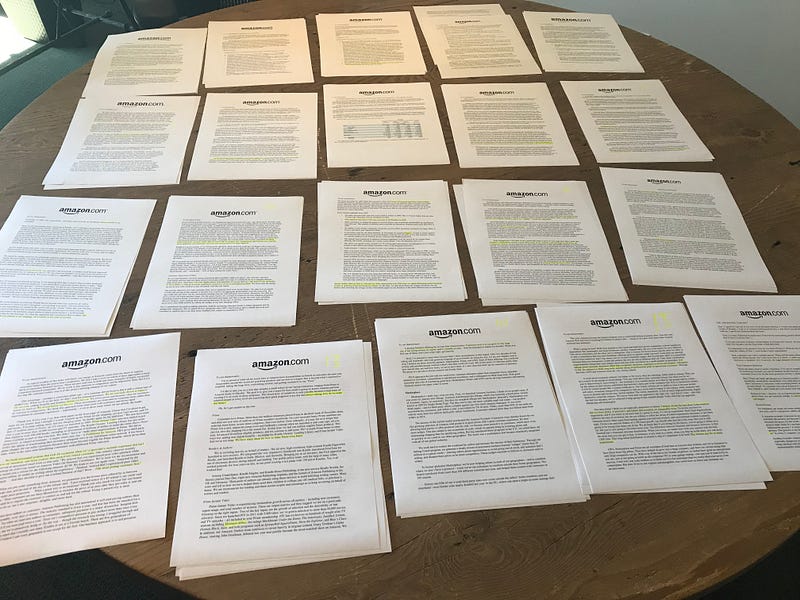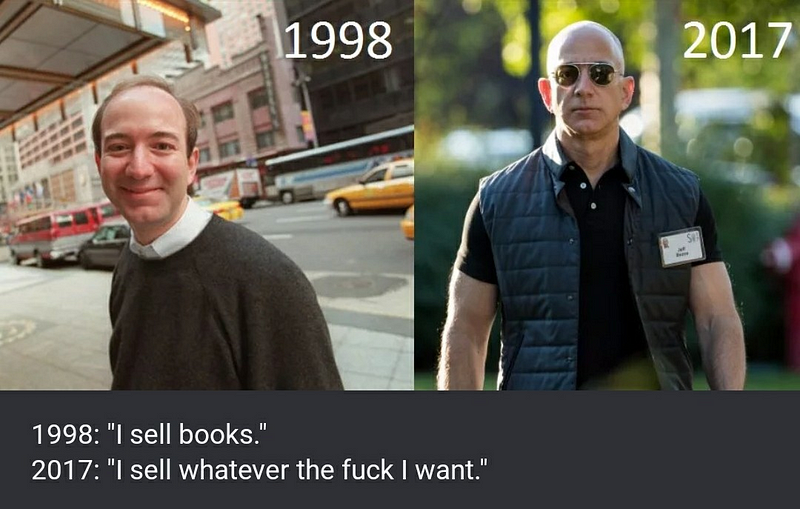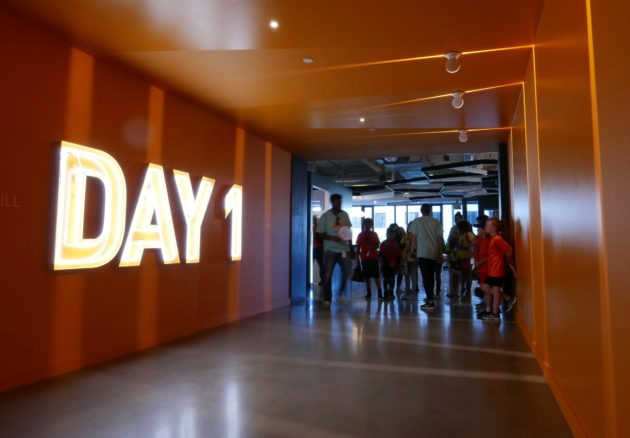What I Learned From Reading Every Amazon Shareholders Letter

A new mentor of mine suggested I read Jeff Bezos’ Letter to Shareholders to refine my thoughts around building a career and a business.
So I read them all dating back to 1997 and here are my takeaways:
1/ Jeff Bezos is still Jeff Bezos
Despite memes (below) to the contrarian, the core operating principles of Amazon hasn’t changed much if at all since the company went public in 1997.
Amazon aims to be the world’s most customer-centric company. In the 1997 letter, Jeff laid out 8 bullet points on Amazon’s philosophy and throughout the years, he repeatedly talks about these principles. I highlight some in this post.
From his 2014 letter on the type of “dreamy” business Amazon aspires to build:
Customers love it, it can grow to very large size, it has strong returns on capital, and it’s durable in time.

Takeaway: determine a handful of core principles for your life or company and compound upon those principles over time.
2/ It’s not about the money, it’s about the f***ing money (h/t Bill “Coach” Campbell)
Many people over the years have criticized Amazon’s lack of interest in “making a profit”. This could not be further from the truth.
Amazon simply has a different lens to look at “profitability” as Jeff outlined in the original 1997 letter:
“When forced to choose between optimizing the appearance of our GAAP accounting and maximizing the present value of future cash flows, we’ll take the cash flows.”
More specifically, Amazon focuses on maximizing long-term free cash flow per share.
When Amazon drops their prices, they actually know that this strategy decreases revenue and margin in the short term. And they know the price elasticity well enough to know almost exactly how much money they are losing by doing this, but they are building long term value for their customers. In turn this strategy attracts more customers to Amazon who spends more in the Amazon ecosystem over time and increases the long-term value of the company.
Jeff uses the entire 2004 letter to explain why measuring by long-term free cash flow per share is a better way to manage a company. I won’t go into the example (read his 2004 letter!). But suffice it to say, if you can put $1 into an engine and generate many $ of cash back over a reasonable period of time, you would be a happy owner of the business.
Takeaway: doing the right thing is better than doing things right. Manage your life and business by the right metrics.
3/ Jeff doesn’t do math like mere mortals, because It’s ALWAYS Day 1.
Jeff invariably ends each year’s annual letter to shareholders by attaching a copy of Amazon’s original 1997 letter with the sign off that it’s “still Day 1”.
To Jeff, being a Day 2 company means decline and death (2016 letter). They become too focused on processes and move too slowly.
A brilliant tactic Amazon uses to make high-quality and high-velocity decision is to say:
Disagree and commit
If a team brings Jeff an idea that he disagree with, he can continue to disagree, but immediately commit to supporting the team. The project gets green-lit and the team is moving forward. If they had to actually convince Jeff of the idea, it would have taken much much longer.
If you are rapidly scaling into a large enterprise, you owe it to yourself to read the entire 2016 letter. Here’s a “snack” from that letter:
Here’s a starter pack of essentials for Day 1 defense: customer obsession, a skeptical view of proxies, the eager adoption of external trends, and high-velocity decision making.

Takeaway: fight corporate entropy like your company’s life depends on it, because it does. Always operate as the hungry upstart in your life.
4/ Elephants can dance, faster and faster.
The size of a company is often an anchor to its growth. While this is true mathematically for its revenue growth, it doesn’t have to be true for other parts of the business.
People build companies, as Sequoia Capital quips on their homepage navigation bar.
Amazon asks for the company to increase the quality of its people as it scales. This is incredibly hard to do. Here are 3 litmus tests Jeff lays out in the 1998 letter:
Will you admire this person?
Will this person raise the average level of effectiveness of the group they’re entering?
Along what dimension might this person be a superstar?
Another gem was in the 2015 letter. Jeff draws distinction between Type 1 versus Type 2 decisions within companies. Type 1 decisions are not reversible, type 2 decisions are easily reversible.
Too many companies treat every decision as a Type 1 decision as opposed to treating most decisions as a Type 2 decision, make them much faster and change course as needed.
Takeaway: improve the quality of your team and your decision-making process even in the face of scaling. On a personal level, commit to doing better work even as you become more successful.
5/ Only the paranoid survive, but don’t focus on the competition.
In 2001, Jeff formally introduced Amazon’s plan of “relentlessly lowering prices” as the third pillar to complement relentless focus on convenience and selection.
Amazon is driven by paranoia, not of their competitors, but of the changing customer preferences and the shifts in product and technology paradigms.
In 2006, Jeff talks primarily about the importance of making bets that are tiny in the beginning to avoid “Innovator’s Dilemma” — not being able to make small bets because a company is so focused on optimizing its larger businesses. Since Amazon has seen many $10 million seeds turn into billion dollar businesses, they are constantly nurturing small ideas and treat them with the same importance as the big ideas.
While Amazon has crushed many of its “competitors”, they do so by relentless focusing on customers and invention.
Takeaway: constantly find ways to learn and improve yourself, even when you don’t “have to”. Because by the time you do, like transitioning to a new career, it might be too late.
6/ Move fast and break things, with stable infra.
Sidebar: you can see by now I’m “mixing metaphors” here by pulling in philosophies from other people like Mark Zuckerberg, Eric Schmidt, Andy Grove, Louis Gerstner, Paul Graham. Perhaps there are some universally applicable lessons from these success stories.
In 2005, Jeff argues that decisions must be made by both judgment and data. Data would suggest lowering prices to be a terrible idea, but judgment would say that delighting customers by lowering prices is an amazing long-term strategy.
In 2008, Jeff argues that companies must make decisions not by doing only things they are already good at, because what you are good at doing might not be valuable to customers. Companies must do things their customers demand, even if those things make them uncomfortable.
Amazon is comfortable with constantly inventing businesses that they have no expertise in. From the 2010 letter:
“Many of the problems we face have no textbook solutions, and we — happily — invent new approaches.
At Amazon, the team is empowered to invent new. In 2013, Jeff wrote about The Mayday Button:
“This decentralized distribution of invention throughout the company — not limited to the company’s senior leaders — is the only way to get robust, high-throughput innovation.”
Risk taking is asymmetric. Big winners pay for so many experiments. In baseball, you are constrained to only getting a maximum of 4 runs, but in business, you can make a bet and get 1,000 runs (2015 letter). Amazon has had just a handful of those — AWS, Alexa, Prime — that’s paid for every experiment.
Takeaway: growth begins at the end of your comfort zone. Stretch yourself in ways where you have the potential of achieving an asymmetric outcome.
7/ If you’re offered a seat on a rocket ship, don’t ask what seat. Just get on.
In 1999, Jeff alluded to the most powerful force driving Amazon. And in 2002, he confirmed that.
Most businesses have to pick between premium offering or lowest prices. Paradoxically, Amazon can both have the best customer service while lowering prices because the underlying technology it sits on top of is improving at the rate of Moore’s Law.
By using technology to transform customer service into a fixed expense, Amazon can simultaneous drive customer experience and lower prices.
In 2014, Jeff clearly articulated the other flywheel that Amazon has developed over the years — the holy trinity of Fulfillment by Amazon (FBA), Marketplace, and Prime. FBA attracts more sellers to join the Marketplace, which increases selection of products, which attracts more Prime customers, which attracts more sellers to sell through the Marketplace and use FBA for logistics.
These are just two examples of Amazon accumulating more power in its platform by building on top of foundational Megatrends.
Takeaway: find a Megatrend you can ride, be it Moore’s Law, compound interest, or just a company that has the potential to be the next Amazon.
8/ Do things that don’t scale…drive the Chevy
When Amazon was just starting, Jeff drove packages to the post office every evening in his Chevy Blazer. His vision was that one day Amazon would get a forklift.
He’s got much fancier rides now (below). But at its core, Amazon executed on Jeff’s simple principles day in and day out for 20 years.
I read all 20 of his letters since Amazon went public and in the end, it all feels as if it was a single letter Jeff wrote in one setting, which is the way it should be. The consistency in which Amazon has executed, even if meant Jeff had to drive his Chevy Blazer to the post office, has allowed it to endure beyond almost all of the Dotcom era companies and will surely propel Amazon into the future.
Takeaway: Rule #1: execute every day. Rule #2: don’t forget Rule #1.

👋🏾 Get to know the people and ideas shaping the products we use every day. Subscribe to Noteworthy — the product & design newsletter written by the Journal team.

Really good post – loved this “In 2008, Jeff argues that companies must make decisions not by doing only things they are already good at, because what you are good at doing might not be valuable to customers. Companies must do things their customers demand, even if those things make them uncomfortable.”